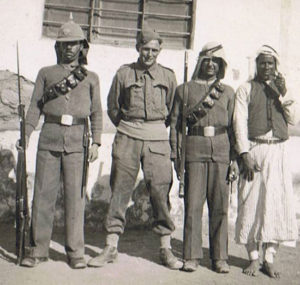Fear and Death Rule Jerusalem As Strife Overshadows Easter, NY Herald Tribune, Mar. 28, 1948.
 Amid a Shaky Truce for Worshipers of Three Religions, Leaders of Jews and Arabs Plan for all-out Battle When British Depart
Amid a Shaky Truce for Worshipers of Three Religions, Leaders of Jews and Arabs Plan for all-out Battle When British Depart
By Fitzhugh Turner
JERUSALEM, March 27.-The Easter season, 1948, finds the city of Christ a place of fear and death-a place where men shoot and stab and blast in hatred while church bells toll incongruously over the sounds of battle.
It is a place where representatives of an empire count it a real achievement to have persuaded Christians, Jews and Muslems not to shoot at worshipers during the Easter-Passover-Nebi Musa religious season. Arrangement of a truce was made easier by the fact that all three communities observe rites or pilgrimages around the same time, but even so, the negotiations required days of hard work by the British district commissioner.
Jerusalem is still a place where a stranger can find peace if he looks for it. At Gethsemane and Bethany, Mt. Zion and the Mount of Olivers and elsewhere around and in the city there are monasteries and shrines and garden spots where the devout still live quietly, not knowing, or not caring, that there is war around them.
These places are remote, however, the peaceful religious are few and the fighters are many. And while the fighters strive daily to kill each other. Holy Week or any week, their leaders make plans for the bigger battle to come. D-Day is May 16, or whenever British forces let the Arabs and the Jews spring at each other’s throats. Both sides say they are prepared. Both say they are confident of victory. Their struggle, unless some outside force prevents it, almost certainly will damage some of the shrines sacred to the three religions, and may well make a ruin of the city itself.
For 100,000 Jews and 65,000 Arabs who live here – men, women and children – the battle threatens to be the bitterest street fighting the world has seen since the Spanish civil war. If the big effort goes as the brutal attrition of the last four months has been going, there will be little quarter shown, and much bloodshed, looting and savagery on both sides. Today, seven weeks or so before the scheduled start of the battle, Jerusalem has the feeling of a city of doom.
Jews in particular feel cornered. Seventeen hundred of them in the Old City have been cut off for weeks, except for an occasional truck convoy escorted by the British Army with Arab permission. The others in the Jewish part of the New City have seen their buildings battered by bombs, their supplies often turned back by the Arabs, their access to the Jewish-controlled coast limited to a harrowing trip cooped up in an armored bus, almost certain to meet attack by bullet or mine. Food is scarce and rationed, kerosene for cooking hard to get, eggs and butter and some other staples almost unobtainable.
While their leaders talk confidently of taking the city when the time comes, the people are frightened. Their fear expresses itself in several ways, all of them in sharp contrast to the general air of confidence in Tel Aviv and the rest of the Jewish coastal plain. For some time, Jerusalem’s Jews have been walled in. Rubble from their bombed buildings has gone into wide stone barriers across streets. Where a Jewish building appears vulnerable, sandbags, tank traps and even trenches have been installed around it.
Terrorists Halt Intruders
There is general chauvinism. The British are allowed in the Jewish area almost not at all. Like Jews in Arab areas, Arabs caught in Jewish areas are likely to be killed. Americans and other foreigners are made to feel unwelcome. Terrorists halt and examine strangers without authority, and seize and question Jewish girls seen with non-Jews.
The battle for Jerusalem will be fought probably around a few tall buildings which dominate the city, on the slopes of Mt. Scopus and other heights and between Jewish and Arab quarters which have faced each other since Dec. 1 across a local no-man’s-land. These quarters already resemble bombed towns in spots. From one or another a daily battle is fought with guns and mortar bombs, sending the population indoors to avoid flying bullets.
Nearly every section of Jerusalem is within rifle range of every section, and both sides are talking of weapons far heavier than rifles-possibly, they say, even artillery.
Shrines Face Damage
With the Church of the Holy Sepulchre already shored up against earthquake, with mosques and synagogues among the dominant buildings and shrines of one religion or another every few yards, there is no telling what artillery bombardment might do to a city which, besides being sacred to millions, is one of the architecturally most beautiful in the world.
Except for Jews on guard or on the offensive, the city retires to its houses soon after dark, and streets become deserted and menacing.
Suspicion exists everywhere, down to the hat-maker who refuses to sell a tar booth to any but an Arab. Pistols, rifles and heavier guns exist in the open.
In streets which Christ walked, in the Old City, arms and ammunition are peddled openly. Strategic buildings on both sides contain armed men covering street corners and road barriers from sandbagged Windows.
The peace that Jerusalem’s population hopes will last through Easter, 1948, is the peace of an armed truce-a calm before a storm which is black upon the horizon.



